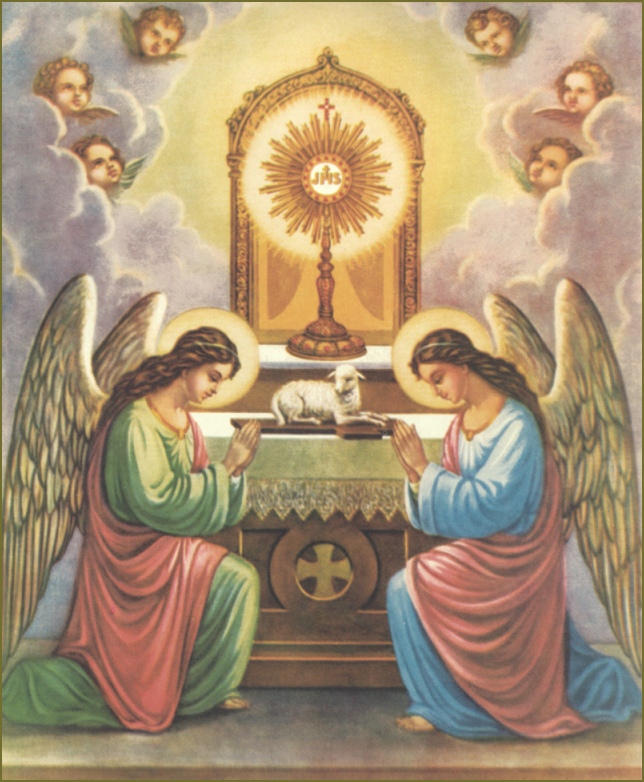Liturgical Time
Bombs
in Vatican II: Excerpts
The Destruction of Catholic
Faith
Through Changes in Catholic
Worship
by
Michael Davies
TAN
BOOKS
Published on the Web with
Permission of the Author.
A Ban on Kneeling for
Holy Communion
Not one of these differences would be
apparent
in a typical Catholic parish celebration in the United States today. As
regards No. 6, standing for Communion, at the end of 2002 the Bishops'
Conference of the United States decreed, apparently in deference to the
principle of a permanently evolving liturgy, that the faithful must
stand
for the reception of Holy Communion. Decisions of an episcopal
conference
are not binding on individual bishops, but even relatively conservative
bishops such as Archbishop Charles Chaput of Denver bowed to the
conference,
which in its turn had kow-towed to its so-called liturgical experts, its
periti, in imposing this diktat. The February 5, 2003 edition of
the Denver Catholic Register carried an exhortation of almost
heroic
banality from the Archbishop:
In
the revised General Instruction on the Roman Missal, the Holy
See
indicated that uniformity of gesture should be respected at this time
in
a specific way. The specific gesture was to be determined by the
appropriate
conference of bishops, and this has been done in the United States. The
bishops have determined that we should not kneel or genuflect. We
receive
Communion standing. Before receiving, we bow our head in adoration, and
we say "Amen" and receive the body of Christ on the tongue or in the
hand.
This will be new for many of the faithful, because the formal act of
reverence
was not widely promoted in the past. This act helps us avoid
nonchalance
in receiving holy Communion. It allows us to acknowledge what we are
about
to do: take under the form of bread and wine the resurrected body and
blood
of Christ.
If
we have become
distracted during the procession, the gesture helps us to recollect
ourselves.
While the act of reverence will be new for some, it may be "different"
for others. In the past, we may have made a sign of the cross, a
profound
bow (one from the waist), genuflected or simply knelt as our act of
adoration.
The Church now asks us to submit our personal preference to her wisdom.
Some of us will need time to remember to do this. Others may not want
to
change the gesture of reverence they've been using. In all cases, we
need
to defer to the Church.
I have rarely seen so many non
sequiturs
in so short a space. If standing helps us avoid nonchalance in
receiving
Holy Communion, does kneeling promote nonchalance? If standing allows
us
to acknowledge that we are about to take under the form of bread and
wine
the resurrected Body and Blood of Christ, does kneeling preclude such
acknowledgment? [Emphasis
in bold added by the Web Master.] If standing helps us to
recollect
ourselves, does kneeling preclude recollection? The Archbishop informs
us that "the act of reverence will be new for some." What utter
nonsense!
Standing is not an act of reverence, and has never been an act of
reverence.
He would profit from reading an article by Father Regis Scanlon,
O.F.M.,
in the August-September 1994 issue of Homiletic and Pastoral Review.
The Franciscan theologian reminds us:
There
is a good reason why the Church reserves the genuflection for its
official
act of reverence toward the Blessed Sacrament. Not just any act can be
used for an act of adoration. For example, one could never use standing
as an act of adoration in our culture nor in the oriental culture. We
stand
when a bishop or the President of the United States comes into the
room,
but we do not adore either one of them. Similarly, today, many bow at
the
presence of great dignitaries and human authority, but they do not
adore
them. This is also the case in oriental cultures today . . . the act of
bending the knee before Jesus Christ is not just a relative act, or an
act that is based purely on culture. Rather, it transcends culture
because
it is an act that has scriptural, traditional, and cosmic significance.
God the Father says through Isaiah: "To Me every knee shall bend" (Is.
45: 23). And St. Paul says, "for it is written: 'As I live, says the
Lord,
every knee shall bend before Me' " (Rom. 14: 11). Again, St. Paul
states:
"at Jesus' name every knee must bend in the heavens, on the earth, and
under the earth" (Phil. 2: 10). And this "kneeling," or "bending of the
knee," is the act of adoration of the Blessed Sacrament which has
developed
in the Tradition of the Church and which the faithful have adopted down
through the ages. St. Francis of Assisi, for example, said in his
twelfth
century Letter to All Superiors of the Friars Minor: "When the
priest
is offering sacrifice at the altar or the Blessed Sacrament is being
carried
about, everyone should kneel down and give praise, glory and honour to
our Lord and God, living and true."
 
HOME------------------- HOLY
EUCHARIST
www.catholictradition.org/Eucharist/v2-bombs7.htm
|

